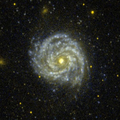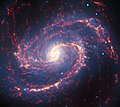Messier 100
Database links to Messier 100
Messier 100 = NGC 4321 is an active barred spiral galaxy with extended Hubble-type SBbc star-forming regions in the constellation Hair of the Berenice in the northern starry sky. It is estimated to be 68 million light-years from the Milky Way and has a diameter of about 155,000 light-years.
Under the catalog designation VCC 596 it is listed as a member of the Virgo Cluster and lies in its extreme northern part. Like almost all spiral galaxies, M 100 is located far from the densely populated center of the cluster. Among the spiral galaxies of this cluster it is the brightest.
In the same area of the sky are among others the galaxies NGC 4312, NGC 4322, NGC 4328, IC 783.
Since its galactic plane is tilted more than 60 degrees from the line of sight, we have a very good view of the galactic disk. This makes it an ideal object of study for all questions concerning spiral galaxies of the Virgo Cluster. In particular, in the H0 Key Project to measure the Hubble constant H0 with the Hubble Space Telescope, M 100 was therefore the first spiral galaxy of this cluster to be resolved into individual stars. This study identified Cepheids, whose period-luminosity relationship allowed the distance of M 100 to be determined to be 55 million light-years. This distance is probably somewhat less than the distance of the cluster center.
Supernovae SN 1901B (type I), SN 1914A, SN 1959E (type I), SN 1979C (type IIL), SN 2006X (type Ia), and SN2019ehk were discovered here, with SN 1979C being exceptional for its X-ray emission, which still persists today.
M 100 is also the main galaxy of the small subgroup Holm 387 within the Virgo Cluster, which also includes mainly dwarf galaxies.
· 
High-resolution image of the centre, Hubble Space Telescope
· 
Ultraviolet absorption by means of GALEX
· 
Messier 100 in the near infrared and in the millimeter range
Discovery
The object was discovered on March 15, 1781 by the French astronomer Pierre Méchain.
Questions and Answers
Q: What is Messier 100?
A: Messier 100 is a type of spiral galaxy, also known as NGC 4321, that is located in the southern part of constellation Coma Berenices.
Q: How far away is Messier 100?
A: Messier 100 is located about 55 million light-years away.
Q: How large is Messier 100?
A: Messier 100 has a diameter of 160,000 light-years, making it one of the largest galaxies in the Virgo cluster.
Q: Who discovered Messier 100?
A: Messier 100 was first discovered by Pierre Méchain in 1781.
Q: When was Messier 100 listed in Messier's catalogue?
A: Messier 100 was listed in Messier's catalogue of nebulae and star clusters about a month after its discovery by Charles Messier.
Q: What is the significance of NGC 4323 and NGC 4328?
A: NGC 4323 and NGC 4328 are two satellite galaxies of Messier 100, with NGC 4323 connected by a bridge of luminous matter.
Q: Who listed Messier 100 as one of 14 spiral nebulae?
A: Messier 100 was listed as one of 14 spiral nebulae by the Earl of Rosse in 1850.
Search within the encyclopedia